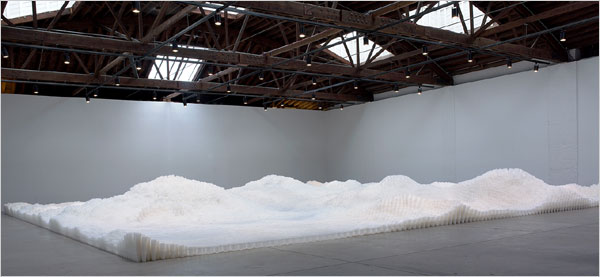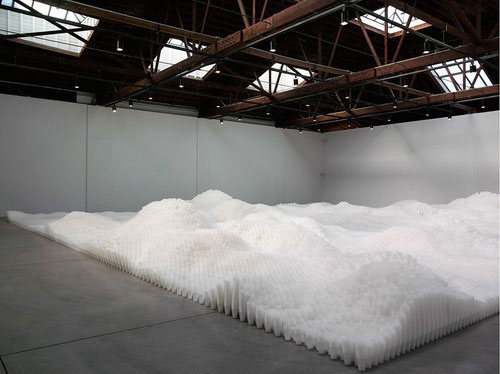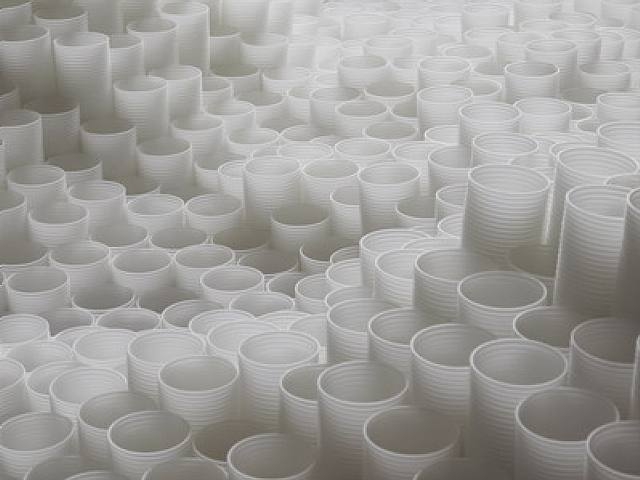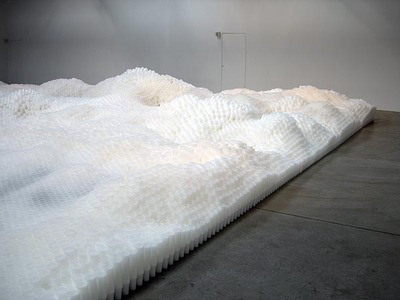Stacked or melted—art made from plastic cups
One way to cultivate creativity is to make art from the mundane. There is tremendous freedom in experimenting with a range of common everyday objects without any preconceived notions. Simply handle the media and reflect on, and then play up, its inherent characteristics. This month’s medium is plastic cups.
In previous months, artists drew on the media’s social and historical associations when they created their works. This month, artists almost exclusively focus on the inherent physical characteristics of the plastic cup. Cups, of course, lend themselves to stacking but how you do that can take you down many different paths. Plastic’s translucence and ability to be easily melted also support expressive explorations.
- Tara Donovan draws out the inherent physical characteristics of plastic cup in her massive Untitled (Plastic Cup) installation (scroll to bottom of her gallery, his installation is the third to the last piece) In this video Tara discusses this piece and her process. In this video, conservation scientists discuss the unique measures for preserving this installation.
- Tom Friedman’s untitled plastic cup ring draws on the same physical characteristics with a different result
- Lisa Hoke’s wall installations leverage the bright colors and patterns afforded by plastic cups
- The Estonian street artists Multistab take the ubiquitous plastic cups in the chain-link fence design to a whole new level. Cupartist also creates chain-link fence art with specially fabricated “plastic cups.”
- Adam Udy’s plastic cup lamp plays on the cups’ translucent qualities. Here are some other plastic cup lamps.
- CDR Studio’s Governor’s Cup Pavilion plays up the cup’s translucence to a different effect.
- Evan Blackwell’s pieces build on many of the physical characteristics used above but also play with the melting potential of plastic cups.
- Jeanette Nyberg’s melted cups evoke Chihuly’s glass sculptures.




The piece is laid out in a perfect grid. The first cup gets glued down, after which it was a matter of unpackaging the cups and stacking them at various heights, sculpting out an undulating landscape that went from, at the highest point, I would guess hundreds of cups down to, in the lowest areas, maybe just a single cup. The building up of the transparent cups allowed different amounts of light to penetrate them, so that the piece wound up looking like a melting snowscape.
— Tara Donovan, in an interview with Lawrence Weschler




The way that we buy in bulk from corporations, I can’t help but think about some of those issues when I am dealing with this. We as consumers, we consume a lot, and we dispose of so much of what we consume. And that is the part that I find particularly shocking, but from an artist’s point of view and pure material, it’s a windfall for me. But it’s sad. There’s a sadness in the disposability of it, and part of when I’m doing this is the hope that people will see that there’s an innate beauty all day long that we encounter. I think we used to just be more economical in how we thought about stuff and how much we used of it. I would hope that if we even saw how beautiful it was, we’d reuse a paper cup sometimes instead of throw everything out after one encounter with it.
— Lisa Hoke, in an interview with Brandy McDonnell, or watch an artist video about her motivation and process
Share your links to other plastic cup art and I will add them to the list. Or, add to the discussion by sharing images of your students’ plastic cup explorations.
NOTE: As the teacher, you will need to consider the benefits of when you share works by established artists. When shown early in the process they can get the creative juices flowing, but they can also lead to self-censoring. Remember, the goal is not to create portfolio-worthy pieces, though that may happen. The goal is to practice thinking expansively and to become more artistically fluent, agile, and responsive.
Please share if you know others who create art made from plastic cups.

These explorations are so much fun for non-imaginative types like me. I now want to make a fence, lamp, and melted sun catcher of my very own.